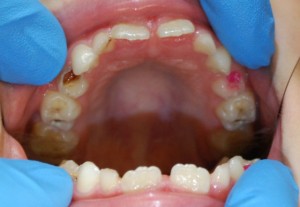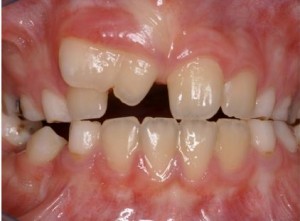Change bite

Change bite - This is a higher degree of development of the dentition, which is characterized by the simultaneous presence of milk and permanent teeth.
The change of milk teeth in children with permanent ones begins after 6 years and usually ends by thirteen years.
Along with the development and growth of the masticatory apparatus, malocclusion occurs.
Features
- Baby's baby teeth give way to permanent - more perfect and stronger teeth.
- The appearance of permanent teeth, like milk teeth, is characterized by a certain sequence and pairing.
- The condition of primary teeth has an impact on the development of future permanent teeth. Destruction of milk teeth with caries, lowering the height of their crowns, as well as premature loss adversely affect the formation of occlusion.
The order and timing of the change of teeth

- The period from 6 to 9 years is considered the first phase of a replacement bite. During this period, the eruption of all permanent incisors and sixes occurs. The Six, the first permanent molar, erupts behind the dairy even before they fall out.
- In the second phase of malocclusion, which begins at the age of 10-12, premolars, second molars and fangs erupt. A sign of the correct course of the second phase is the symmetry and sequence of teething.
Due to the fact that at first the appearance of the first permanent molars occurs, and after the incisors and only after that the other milk teeth fall out, there is no decrease in the interalveolar height.
- The first permanent molars do not become functionally complete immediately, but only after 3-4 years.
- The interalveolar height of up to 10 years is first recorded on milk molars, and after they fall out, this function begins to be performed by constants.
- The full-fledged eruption of the first permanent molars and their correct articulation formulation provide a physiological interalveolar height.
Video: “Stages of changing primary teeth for permanent teeth”
Bite Management
Violation of the process of bite formation is often associated with the defeat or removal of milk teeth, as well as the first permanent molars.
Therefore, an important factor in preventing the development of anomalies is the preservation of the baby’s milk teeth until their physiological change.
The first permanent molars, in addition to the growth of the alveolar processes, influence the formation of the correct interalveolar height, the full chewing function, the dynamics of the development of dentition and the correct symmetry of the face.
It is important to understand that any removal of milk teeth more than a year before their change in a natural way leads to the development of defects and malocclusion anomalies.

- When teeth are removed at the age of six, asymmetry of the dentition develops, the median line shifts towards the missing tooth, the growth of the alveolar bone is delayed, and movements of the lower jaw are blocked. Removal of teeth at the age of 9 years does not lead to the development of pronounced asymmetry.
- If the removal of the sixth tooth occurs, before the seventh tooth appears, it leads to a decrease in the interalveolar height. The erupted seventh tooth replaces the removed sixth. At the same time, a pronounced asymmetry of the dental arch is observed in such a way that the median line passes between the incisors on the side of the stored first permanent molar.
- With unilateral extraction of teeth by 12 years, the clinical picture is clearly expressed.